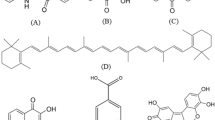Abstract
Amaranth (E123) and Allura red (E129), very important food azo dyes used in food, drug, paper, cosmetic and textile industries, were assessed for their genotoxic potential through comet assay in yeast cells. Comet assay was standardized by with different concentration of H2O2. Concentrations of Amaranth and Allura red were maintained in sorbitol buffer starting from 9.76 to 5,000 μg/mL and 1 × 104 cells were incubated at two different incubation temperatures 28 and 37°C. Amaranth (E123) and Allura red (E129) were found to exhibit their genotoxic effect directly in Saccharomyces cerevisiae. No significant genotoxic activity was observed for Amaranth and Allura red at 28°C but at 37°C direct relation of Amaranth concentration with comet tail was significant and no positive relation was seen with time exposure factor. At 37°C the minimum concentration of Amaranth and Allura red at which significant DNA damage observed through comet assay was 1,250 μg/mL in 2nd h post exposure time. The results indicated that food colors should be carefully used in baking products as heavy concentration of food colors could affect the fermentation process of baking.
Similar content being viewed by others
References
Anonymous (1996) The mechanism of benzene-induced Leukemia: a hypothesis and speculations on the causes of leukemia. Environ Health Perspect 104:1219–1225
Anonymous (2000) Allura red. National toxicological programe (NTP). http://ntpserver.Niehs.nih.gov/cgi/iH_Indexes/ALL_SRCH/Ih_ALL_SRCH_Frames.html. Acccessed 13 Nov 2000
Borzelleca JF, Olson JW, Reno FE (1989) Lifetime toxicity/carcinogenic study of FD and C red no. 40 (allura red) in Sprague-Dawley rats. J Food Chem Toxicol 27:701–705
Chung KT, Cemiglia CE (1992) Mutagenicity of azo dyes: structure activity relationship. J Mutat Res 277:201–220
Collins TF, McLaughlin J (1972) Teratology studies on food colourings: I. Embryotoxicity of amaranth (FD and C red no. 2) in rats. J Food Cosmet Toxicol 10:619–624
Collins TF, McLaughlin J (1973) Teratology studies on food colourings: II.Embryotoxicity of R salt and metabolites of amaranth (FD and C red no. 2) in rats. J Food Cosmet Toxicol 11:355–360
Collins TF, Black TN, Ruggles DI, Gray GC (1976) Teratological evaluation of FD and C Red no. 2 a collaborative government industry studies : FDA‘s study. J Toxicol Environ Health 5:857–862
Collins TF, Black TN, Welsh JJ, Brown LH (1989) Study of the teratogenic potencial of FD and C red no. 40 when given by gavage to rats. J Food Chemical Toxicol 27:707–713
Combes RD, Haveland-Smith RB (1982) A review of the genotoxicity of food, drug and cosmetic colours and other azo, triphenylmethane and xanthene dyes. J Mutat Res 98:101–243
Flint OP, Orton TC, Ferguson RA (1984) Differentiation of rat embryo cells in culture: response following acute maternal exposure to teratogens and non-teratogens. J Appl Toxicol 4:109–116
Horvathova E, Slamenenova D, Hlicikova L, Mandal TK, Gabelota A, Collins AR (1998) The nature and origin of DNA single strand breaks determined with the comet assay. J Mutat Res 409:163–171
Jabar Al-Mossawi MA (1983) The mutagenic effect of amaranth (FD and C red no.2) in bacteria and yeast. J Environ Int 9:145–148
Lah B, Gorjanc G, Nekrep FV, Marinsek-Logar R (2004) Comet assay assessment of waste genotoxicity using yeast cells. J Environ Contam Toxicol 72:607–616
Larsson KS (1975) A teratologic study with the dyes amaranth and ponceau 4R in mice. J Toxicol 4:75–81
Macioszek VK, Kononowicz AK (2004) The evaluation of the genotoxicity of two commonly used food colors; quinoline yellow (e104) and brilliant black BN (E151). J Cell Mol Biol Lett 9:107–122
Novick P, Bostein D (1985) Phenotypic analysis of temperature sensitive yeast action mutants. J Cell 40:405–406
Piersma AH, Attenon P, Bechter R, Govers MJ, Krafft N, Schmid BP, Stadler J, Verhoef A, Verseil C (1995) Interlaboratory evaluation of embryotoxicity in the post implantation rat embryo culture. J Reprod Toxicol 9:275–280
Sasaki YF, Kawaguchi S, Kamaya A, Ohshita M, Kabasawa K, Iwama K, Taniguchi K (2002) The comet assay with 8 mouse organs: results with 39 currently used food additives. J Mutat Res 519:103–119
Singh RK, Mishra SK, Kumar N, Singh AK (2010) Assessment of DNA damage by comet assay in lymphocytes of workers occupationally exposed to petroleum fumes. Int J Gen 2:18–22
Terziyska A, Waltchewa L, Venkow. (2000) A new sensitive test paste on yeast cells for studying environmental pollution. J Environ Pol 109:43–52
Tice RR, Agurell E, Anderson D, Burlinson B, Hartmann A, Kobayashi H, Miyamae Y, Rojas E, Ryu JC, Sasaki YF (2000) Single cell gel/comet assay: guidelines for in vitro and in vivo genetic toxicology testing. J Environ Mol Mutagen 35:206–221
Acknowledgments
The authors are very much indebted to the technical staff of the molecular diagnostic laboratory, Institute of Microbiology for extending all the basic facilities in the completion of the project.
Author information
Authors and Affiliations
Corresponding author
Rights and permissions
About this article
Cite this article
Jabeen, H.S., ur Rahman, S., Mahmood, S. et al. Genotoxicity Assessment of Amaranth and Allura Red Using Saccharomyces Cerevisiae . Bull Environ Contam Toxicol 90, 22–26 (2013). https://doi.org/10.1007/s00128-012-0870-x
Received:
Accepted:
Published:
Issue Date:
DOI: https://doi.org/10.1007/s00128-012-0870-x




